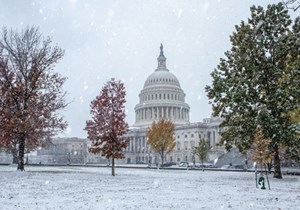“The government which governs least governs best”
“The government which governs least governs best” is a quote that is often attributed to President Thomas Jefferson (1801-1809), although that attribution appears to be erroneous. The actual source for the quote more likely comes from an essay published in 1849 by Henry David Thoreau, entitled “Resistance to Civil Governance (Civil Disobedience).”
Regardless of which public figure first said it, as a general rule, the oil and gas industry endorses its logic. On Nov. 6, the country’s voters, by creating a once-again divided federal government, just signaled their endorsement of it as well, at least for the next two years.

For the most part, a divided government is the best kind of federal regime, where the upstream industry is concerned, Fig. 1. This is an industry that places a high degree of importance on regulatory and statutory certainty, and a divided government tends to result in a slower pace of change in these areas.
The unified, Republican-controlled government of the past two years produced a rapid pace of change, although much of it has actually been favorable for the industry, as the Trump Administration has gone about revising and repealing a raft of Obama-era actions. But that work is now mostly done, although the ultimate resolution for the EPA’s Waters of the United States rule, and various methane-related measures at EPA and the Department of the Interior, remain somewhat up in the air for now.
Congress was able to agree to include energy-related provisions in its omnibus spending bill last December, but the Legislative Branch has done little related to energy since.
LAME DUCK SESSION WILL BE BUSY
The lame duck session of the current 115th Congress that has been convening during November and December will have to try to deal with a broad range of potential legislation. The current GOP majorities will try to cram in as much as they can before they give way to the 116th Congress in January.
Most crucial for oil and gas is the FY 2019 appropriations bill for the Departments of Interior (DOI) and Energy (DOE), which was extended through Dec. 7 as part of the “mini-bus” appropriations bill passed at the end of September. DOI and DOE, together with the EPA, do the most to regulate oil and gas activities at the federal level, and the appropriations bill always impacts how their actions will be carried out in the coming year.
The lame duck session also is likely to pass the annual “tax extenders” legislation that includes a few oil-and-gas-related provisions. This bill also includes provisions related to biofuels and other renewable energy sources, and typically attracts broad, bi-partisan support.
House Ways and Means Committee Chairman Kevin Brady (Rep.-Texas) laid out his priorities for tax-related legislation shortly after the election, and made it clear he would like to include language on additional tax cuts in his tax extenders bill. Specifically, he said he would like to see elements of the “Tax Reform 2.0” bill that the House passed in September included in any lame duck session tax bill. That September bill never saw action in the Senate, and there is little reason to expect further tax cuts to attract any of the Democratic support that would be needed there during the Lame Duck session.
Another key bit of legislation that won’t receive much media attention will be the re-authorization of DOI’s Land and Water Conservation Fund (LWCF), a popular program whose sources for funding expired at the end of September, although the program, itself, remains in place. While there is broad, bipartisan support for the program’s continuance, the debate will be over whether to continue to require its funding to be reauthorized every year, or to award it permanent funding status. The latter would be via an automatic draw from the revenues collected from oil and gas exploration activities in the Gulf of Mexico and other federal waters.
ANTI-OIL AND GAS PROPOSITIONS FAIL
The other big energy-related outcome from the mid-term elections was the failure of several anti-oil-and-gas ballot propositions at state and local levels.
Colorado. Most notable among these was Colorado’s Proposition 112, which would have enacted a 2,500-ft setback rule. It was defined in such a way that, according to at least one independent study, it would have effectively shut down oil and gas development in the state, Fig. 2. With pretty much every major newspaper and political leader in both parties opposing it, Prop 112 failed dramatically, receiving just 42% of the vote.

One interesting part of the outcome of this vote is that Coloradans rejected it by a 16% margin, a result that has remained very consistent in such efforts to kill the state’s oil and gas industry for the last decade. As Simon Lomax with Vital For Colorado pointed out in August, the first such ballot measure, pursued by out-of-state activist groups in the state during 2008, failed by the same margin:
A 2008 ballot measure targeting Colorado’s oil and gas sector—Initiative 58—was beaten by a wide margin of 58-42 percent. It was the same year Barack Obama accepted the Democratic presidential nomination at Mile High Stadium. President Obama, who ran as a critic of the oil and gas industry during the 2008 election, decisively won Colorado. It was a wave election nationally, with the president’s party winning huge majorities in Congress and maintaining its control of the state legislature.
Initiative 58 had the strong support of then-Gov. Bill Ritter (D), and it was much less extreme than this year’s Initiative 97. Instead of an effective statewide drilling ban, Initiative 58 would have hiked taxes on oil and gas development—and still it lost by 16 percentage points.
Spokespersons for the supporters of Prop. 112, of course, promised to keep pursuing the measure in future election cycles, presumably because they are well-funded and have nothing better to do with their lives. But the industry should take heart in the broad, bi-partisan opposition that this proposal attracted, a fact that bodes well for future fights.
Alaska. Also failing was Alaska’s Ballot Measure 1, which would have placed onerous new permitting rules and fees on the industry, which is far and away the largest funding source for the state’s government. Advertised as an effort to protect salmon habitat, this measure was, in reality, little different from Colorado’s Prop 112: a thinly-disguised attempt to increase costs and regulatory burdens on energy and other mineral development in the state.
That initiative received just 36% favorable votes on Nov. 6. Spokespeople for Stand for Salmon, the organization pushing the measure, promised to return for another bite at this particular apple in future election cycles. But again, as in Colorado, this initiative attracted strong, bi-partisan opposition from public policy leaders.
Washington state. Ballots in Washington state featured Initiative 1631, a proposal that would have created the nation’s first state-level carbon tax. Though proponents of the bill styled it as a “fee,” it was, in fact, a tax that would have been levied on oil and gas producers, power providers and a vast array of other businesses, whose activities result in carbon emissions within the state. The “fee” would have started at $15/ton and then been raised by $2/ton each year through 2035 as an incentive to reduce emissions.
The funds raised by the tax—initially estimated to be about $1 billion/year in the early years—would have theoretically gone toward clean energy projects, public transportation, environmental conservation, and “green” jobs programs, although the state’s legislature would have had broad power to redirect the funds as it saw fit.
Ohio. Finally, voters in Youngstown, Ohio, rejected a ballot effort to ban hydraulic fracturing and other oil and gas operations within its city limits. This was no less than the eighth time since 2013 that the voters in Youngstown have rejected this ballot provision, or ones very similar to it.
As it has in the past, the editorial board of the Youngstown Vindicator opposed the measure, using somewhat delightful prose:
“What part of ‘no’—multiplied tens of thousands of times over in votes over five years—do the self-appointed do-gooder backers of the Youngstown Drinking Water Protection Bill of Rights [not] understand?
Apparently not much, given their foolish and unrelenting pursuit of their misguided and foolhardy proposal.
After all, responsible and civic-minded Youngstown residents have convincingly and resoundingly said no to the jobs-killing initiative seven times over now—from 2013 to the 2018 primary election.”
Couldn’t have said it better myself.
CONCLUSION
The momentum at the back of the Democratic Party was not strong enough to result in the “Blue Wave” that the news media had spent the last year predicting, but it was strong enough to create a “mini-wave” that turned over control of the House of Representatives. That outcome dims the prospects for any bi-partisan agreement on significant energy-related legislation, or indeed, even the passage of actual appropriations bills, for the next two years. This new reality, combined with the Trump Administration’s lack of desire to enact new regulations that would hamper energy development of any kind, is likely to create a largely gridlocked federal policy environment through the end of 2020.
Where the industry is concerned, a gridlocked federal policy environment is pretty much the optimal situation. ![]()


